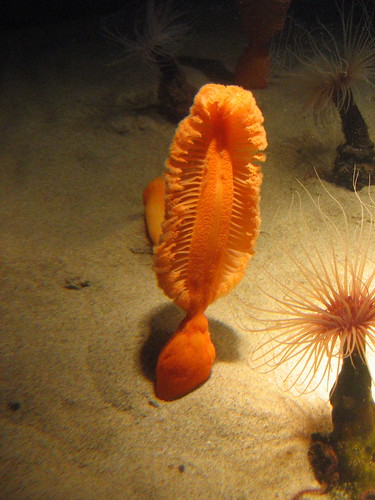Name
The sea pens are types of soft coral of the order Pennatulacea, sub order Subselliflorae. The name 'sea pen' arises from their feather-like appearance which resembles a quill pen. |
| Photo by fiveinchpixie |
Life Cycle
A sea pen is a colonial animal, which means it is made up of individual polyps which together function as a whole animal. It begins life as a larva which roots itself and then develops into a stalk. This stalk is called a rachis. It has a root-like structure at its base which anchors it to the sea floor. Both this and this stalk are strengthened by calcium carbonate. The feather-like protrusions are made up of two new types of polyps formed through asexual reproduction. These polyps are responsible for feeding (gastrozoids) and respiration (siphonozoids). The gastrozoids capture food while the siphonozoids move water around to allow for gas exchange.Some species reproduce by releasing eggs and sperm into the water, whereas in others the female retains the eggs and fertilisation is internal. The developing embryos are brooded until they have reached an advanced larval stage when they are released into the water, where they root to form new pens.
Habitat
Sea pens prefer deeper water, from 10 m to 2 km deep, where they are less likely to be uprooted. They tend to stay in one place but can re-establish themselves if necessary. They position themselves so currents ensure a steady flow of plankton, their main source of food.Threats and Defences
Unfortunately, sea pens are often destroyed by prawn trawlers and dredgers as well as being prey for sea stars and nudibranchs. In defence, a sea pen may luminesce or deflate and retreat completely underground.Sources
- http://en.wikipedia.org/wiki/Sea_pen
- http://www.bbc.co.uk/nature/blueplanet/factfiles/jellies/seapen_bg.shtml
- http://www.naturalengland.org.uk/ourwork/marine/protectandmanage/mpa/mcz/features/habitats/seapen.aspx
- http://www.marlin.ac.uk/speciesfullreview.php?speciesID=3353#
- http://www.advancedaquarist.com/2003/10/inverts
- http://www.ehow.com/about_6418563_sea-pens.html
No comments:
Post a Comment